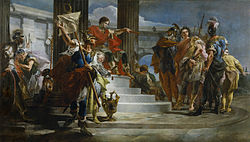Lahabali kɔligu:Giovanni Battista Tiepolo - Scipio Africanus Freeing Massiva - Walters 37657.jpg

Jɔhiyuli maa galisim:800 × 453 anfooni bihi bihi. Din pahi resolutions: 320 × 181 anfooni bihi bihi | 640 × 362 anfooni bihi bihi | 1,024 × 580 anfooni bihi bihi | 1,798 × 1,018 anfooni bihi bihi.
Faal maa maŋmaŋa (1,798 × 1,018 pixels, file size: 2.28 MB, MIME type: image/jpeg)
Faal tarihi
Dihimi dabisili/saha n-nya kɔl' bihi kamani di ni di yina shɛm
| Zuŋɔ dabisili/Saha | Thumbnail | Di tarisi | ŋun su | tɔhibu | |
|---|---|---|---|---|---|
| din na chana | 22:36, 21 Silimin gɔli March 2012 |  | 1,798 × 1,018 (2.28 MB) | File Upload Bot (Kaldari) | == {{int:filedesc}} == {{Walters Art Museum artwork |artist = {{Creator:Giovanni Battista Tiepolo}} |title = ''Scipio Africanus Freeing Massiva'' |description = {{en|As described by the Roman historian Livy (1st century BC), t... |
Lahibali kɔligu zaŋ tum tuma
Din doli ŋɔ na yaɣili tuma nima zaŋ ti lahabali kɔligu ŋɔ:
Duniya zaa lahabali kɔligu zaŋ tum tuma
Wikis shɛŋa ŋan dolina ŋɔ gba malila faal ŋɔ n kuri bukaata:
- Zaŋ tum tuma arz.wikipedia.org zuɣuc
- Zaŋ tum tuma bg.wikipedia.org zuɣuc
- Zaŋ tum tuma ca.wikipedia.org zuɣuc
- Zaŋ tum tuma cs.wikipedia.org zuɣuc
- Zaŋ tum tuma en.wikipedia.org zuɣuc
- Zaŋ tum tuma eo.wikipedia.org zuɣuc
- Zaŋ tum tuma es.wikipedia.org zuɣuc
- Zaŋ tum tuma fr.wikipedia.org zuɣuc
- Zaŋ tum tuma hy.wikipedia.org zuɣuc
- Zaŋ tum tuma it.wikipedia.org zuɣuc
- Zaŋ tum tuma ko.wikipedia.org zuɣuc
- Zaŋ tum tuma nl.wikipedia.org zuɣuc
- Zaŋ tum tuma pt.wikipedia.org zuɣuc
- Zaŋ tum tuma ro.wikipedia.org zuɣuc
- Zaŋ tum tuma ru.wikipedia.org zuɣuc
- Zaŋ tum tuma sl.wikipedia.org zuɣuc
- Zaŋ tum tuma sr.wikipedia.org zuɣuc
- Zaŋ tum tuma www.wikidata.org zuɣuc




